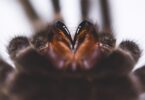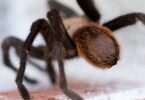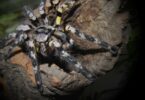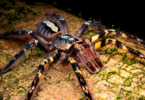Understanding Tarantula Webs
Have you ever wondered if the mighty tarantula spins a web like its other spider cousins? Despite their fearsome reputation, these fascinating creatures do indeed use silk—just not in the way you might expect.
In this blog post, we’ll unravel the mysteries behind tarantula webbing and discover what purposes it really serves. Get ready to be surprised!
How They Are Built
Tarantulas are primitive spiders. They make webs differently from others.
- Tarantulas use their back end, called spinnerets, to create silk. This comes out as a liquid and hardens in the air.
- Their eight legs help them shape the silk. They move in special ways to form the web.
- The silk can make a soft lining for their homes. It covers the walls of their burrows in the ground.
- Some tarantulas stretch silk across openings. This helps them feel when prey or danger is near.
- The webs aren’t used to catch food. Instead, they protect and give tarantulas a place to hide.
- During molting, when tarantulas shed their skin, they lay down extra silk. It keeps them safe while they’re weak.
- Males spin a special kind of web before mating. They put sperm into it and then take it into their palpal bulbs on their front legs.
- Tarantula webs might also attach to surfaces so they don’t fall in steep places.
- Not all build webs, though. Some might not need to because of where they live or how they hunt.
- But those that do spin use this amazing skill to survive and thrive in many ways!
What do tarantula webs look like?
N.incei web
After learning how tarantulas craft their webs, it’s easy to wonder about their appearance. These webs don’t look like the classic spider web that Spiderman slings from building to building.
Instead, they are more like a silky blanket or carpet. The silk can line a burrow in the ground or cover the sides of a terrarium. It’s not made for catching prey but serves as a comfy home base for these big, hairy spiders.
Tarantula webs may also appear messy and less organized than cobwebs you might find in an old house’s corners. Their silk threads crisscross without any clear pattern.
A female tarantula’s egg sac is another masterpiece built with silk; it keeps her babies safe until they’re ready to hatch and venture out on their own hairy-legged adventures!
The Functionality of Tarantula Webs
Curious about the silk-spinning skills of tarantulas? Their webs aren’t just random threads – they serve crucial purposes. From cozy burrow linings to vital roles during their most vulnerable moments, each strand weaves its own tale in the life of these fascinating arachnids.
Lining Their Burrows
Tarantulas use their silk to make their homes safe. They spin webs inside the holes they live in. This stops the walls from falling in. The spider keeps making its burrow bigger as it grows larger.
Young tarantulas might hide under rocks or logs with just a thin web for cover.
After talking about how they line their burrows, we can look at another way webs help these big spiders—keeping them safe when they shed their old skins.
Protection During Molting
Molting is a tricky time for tarantulas. Their old skin gets too tight, and they need to wriggle out of it to grow. While they do this, their bodies are soft and can be hurt easily.
So, they spin molting mats out of silk. These special webs act like a cozy blanket that keeps them safe.
Silk glands must stay in good shape for making these mats. That just shows how important those silk-making parts are! They’re always ready to protect even when the spider isn’t in control.
Anchoring On Surfaces
Tarantulas have fragile bodies. They use silk to stick to places safely. This helps them live and not get hurt. Their webs are not like other spider webs that catch bugs in the air.
Tarantula webs hold onto the ground or walls of their homes.
These spiders really need to anchor themselves, especially when they’re growing a new skin! Think about it – if they didn’t stick down, molting could be dangerous for them. Spiders have been around for millions of years because they are so good at sticking to surfaces.
It’s important for staying safe and catching food too!
For Reproduction
Tarantulas also create silk when reproducing; a cocoon is formed from it, containing the offspring. Male tarantulas, before attempting copulation, produce a small mat of silk on which they deposit their sperm.
Reason Why Tarantulas May Not Web
Not all tarantula species produce large amounts of silk; this is common among African tarantulas, where nearly every spider spins webs.
An example of why your tarantula, known for massive webbing, might not spin webs could be due to stress or illness.
H.maculata house web
Conclusion
So, tarantulas do more with silk than you might think. They line homes, stay safe when soft, and even use it in love! Remember these cool spiders the next time you spot a web. It’s not always about catching dinner – sometimes it’s about setting up for tomorrow.
Tarantulas remind us that nature has many surprises!
FAQs
1. Do tarantulas build webs?
Yep, they sure do! Tarantulas make webs – but not the way you’re thinking, like a big web for catching bugs. They use their silk more for making a cozy home or laying down a trail.
2. Can all tarantulas make webs?
True story: while every tarantula can spin some silk, not all of them fancy making actual “webs”. Some just do it to tidy up their burrow or get ready to molt.
3. What’s this about a tarantula sperm web?
Oh, that’s an interesting bit! Male tarantulas whip up what’s called a sperm web before they go find a lady spider. It’s kinda their prep work for mating.
4. Are there other reasons why tarantulas spin webs?
You bet! Apart from home-making and mate-seeking, these eight-legged friends might also create tripwires to alert them of tasty snacks wandering by!
5. Do all tarantulas build webs?
With many exceptions, species responsible for producing a significant amount of silk come from Africa.





